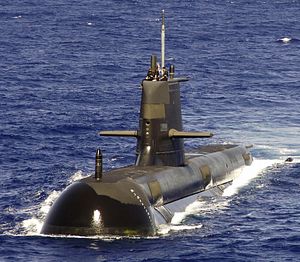The fight for Australia’s future submarine contract continues. As previously reported by the Diplomat, Canberra is currently considering a replacement for its six aging Collins-class subs, originally designed by Swedish manufacturer Kockums in the 1990s. The three contenders still in the so-called SEA-1000 acquisition project are Japan’s Soryu-class, German ThyssenKrupp’s Type-216–class and a collaborative offer between the French companies DCNS and Thales. The Australian government has stated that it will announce the winner of SEA-1000 by early 2016.
The French seem to have stepped up their game. According to Defense News, DCNS recently announced that it had filed a draft proposal outlining its finalized offer. The French offer is based on the Barracuda-class, the planned replacement for France’s Rubis, the current mainstay of its nuclear submarine fleet. To match Australian specifications of a conventional, non-nuclear sub, DCNS is offering an amended version of the Barracuda, the Barracuda Shortfin Block 1A (click here to see DCNS’ promotional video of the proposed sub.)
Although the details of the French bid are still classified, DCNS has revealed that the Shortfin Barracuda is over 90 meters in length and displaces more than 4,000 tons when submerged. This represents a significant increase from the Collins, which is 72 meters and displaces just over 3,100 tons under water.
Some of the key requirements for the Barracuda SSN are long endurance and high transit speed. The conventional Shortfin Barracuda will supposedly retain these intrinsic qualities. According to Xavier Mesnet, marketing director for Surface Ships and Submarines at DCNS, the submarine “will be able to deploy far away, quickly and for a significant on-station period.”
One of DCNS’ major selling points is that Australia would benefit from France’s own operational experience with the Barracuda. The first delivery of the Barracuda to the French Navy is expected to be in 2017, some six months later than previously scheduled. As Canberra has stated that it plans to replace the Collins by the mid-2020s, this ostensibly gives the French company plenty of time to smooth out any inevitable technical glitches with the subs before they are launched in Australia.
However, the French Barracuda program has previously been mired in controversy. Like many ambitious military hardware acquisitions, the project has run into delays and cost overruns. Since then, DCNS seems to have brought the Barracuda program under control. The company has gone through reorganization, including appointing a new Barracuda program director last October.
Much of the French company’s chance of winning the bid will depend upon how much the Australian government trusts that there will be no further delays. The Collins-class also experienced significant problems at the beginning of its Australian service. According to several commentators, fundamental design flaws resulted in poor performance and frequent repairs. Canberra will be anxious to ensure that this won’t be repeated with the Collins’ replacement.
The French bid seems impressive. If DCNS delivers, the Barracuda Shortfin could be a worthy replacement for the Collins. However, major defense acquisitions, especially of platforms that haven’t been built yet, is have a habit of cost overruns and delays. (F-35, anyone?)

































